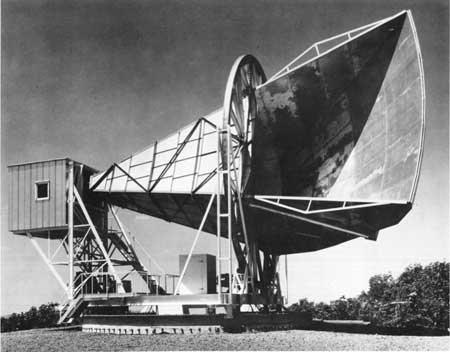This blog post was written by Jonathan Frazer.
The pigeon problem
In 1964, Bell Labs built a new antenna which was designed to detect the radio waves bounced from echo balloon satellites, but there was a problem with the antenna. The signal was far less clean than they were expecting. The first theory seeking to explain this signal was the pigeon droppings theory. A pair of pigeons had built a nest in the antenna and so the hypothesis was that by removing these pigeons, the signal would be improved.
In general, one of the perks of being a cosmologist is that there are very few ethical issues to worry about. I am sad to say however that in this instance, extreme measures were taken. The pigeons were shot. What is more, they died in vain since the noisy signal persisted. The pigeon droppings theory was ruled out.

The Holmdel Horn Antenna. Photo Credit: Bell Labs
At this point a new theory became popular. Rather than the unwanted signal being caused by pigeon waste, it was now proposed that the source of contamination could be explained by a controversial theory known as the Big Bang. Largely the result of philosophical bias, for a long time it had been thought that the Universe had always existed, staying much the same for all eternity. This new theory proposed there was in some sense a beginning to our Universe. A particularly nice feature of this theory was that it had a number of striking predictions relating to the fact that soon after the Universe came into existence, it would be very hot and very dense. One of these predictions was that a simple series of cosmic events would take place as the universe expanded, and this would result in radiation that should be observable even today. It was this radiation that caused the problem at Bell Labs.
The problem of predictability
This radiation, often referred to as the cosmic microwave background (CMB) is remarkable in many ways and plays a role of paramount importance in testing both theories of the early universe, and theories of late time structure formation. One important characteristic is that almost nothing has interfered with this radiation since its creation; it is essentially a snapshot of the universe, soon after its birth.
This brings me to the problems we face today, and hence also the work I have done in my thesis. There is a beautiful theory of the early universe known as inflation. This theory describes how quantum fluctuations are the seeds that eventually grow to become the complex structures we see today, such as galaxies, stars and even life. In order to test this theory, it is essential that we understand with great precision how these quantum fluctuations will be imprinted in the CMB. A significant part of my work to date has been to develop better methods of doing this.
However, testing the theory of inflation has turned out to be rather more challenging than first expected. As I mentioned, the early universe was very hot and very dense which means that any theory of the early universe inevitably involves studying particle physics at energy scales far far greater than anything we could ever hope reproduce in an experiment on Earth. This means we must study particle physics at a more fundamental level. This leads us to string theory!
String theory famously suffers from the problem that it is exceedingly difficult to test experimentally. So the prospect that there may be information encoded in the CMB, for many physicists, is very exciting! That said, there is a serious problem. Historically, theories of inflation were very simple and much like the pigeon theory, they were easy to test. Typically there would be only one species of particle that needed to be considered and this would mean it was straightforward to make a prediction. However, again much like the pigeon theory, it seems these theories are too basic and the reality may be significantly more complex. Recent developments in string theory have resulted in inflationary models becoming vastly more complex. Often containing tens if not hundreds of fields which need to be taken into account, this has resulted in a class of models where it is no longer understood how to make predictions.
Fortunately there is reason to think this challenge can be overcome. While the underlying structure of this new class of models can be exceedingly complicated, the combined effect of all the messy interactions between these many particles can actually result in a wonderfully simple and consistent behaviour. It is far too soon to say whether or not this result is generic but this emergent simplicity may hold the key to understanding how string theory can finally be tested!
Jonathan Frazer
Predictions in multifield models of inflation, submitted to JCAP.
Mafalda Dias, Jonathan Frazer, Andrew R. Liddle
Multifield consequences for D-brane inflation, JCAP06(2012)020.
David Seery, David J. Mulryne, Jonathan Frazer, Raquel H. Ribeiro
Inflationary perturbation theory is geometrical optics in phase space, JCAP09(2012)010.
Jonathan Frazer and Andrew R. Liddle
Multi-field inflation with random potentials: field dimension, feature scale and non-Gaussianity, JCAP02(2012)039.
Jonathan Frazer and Andrew R. Liddle
Exploring a string-like landscape, JCAP02(2011)026.
